Archived Storm Damage Blog Posts
What to Do After a Fall Storm: Essential Steps for Home Damage Recovery in Colorado | SERVPRO of Pueblo
10/17/2024 (Permalink)
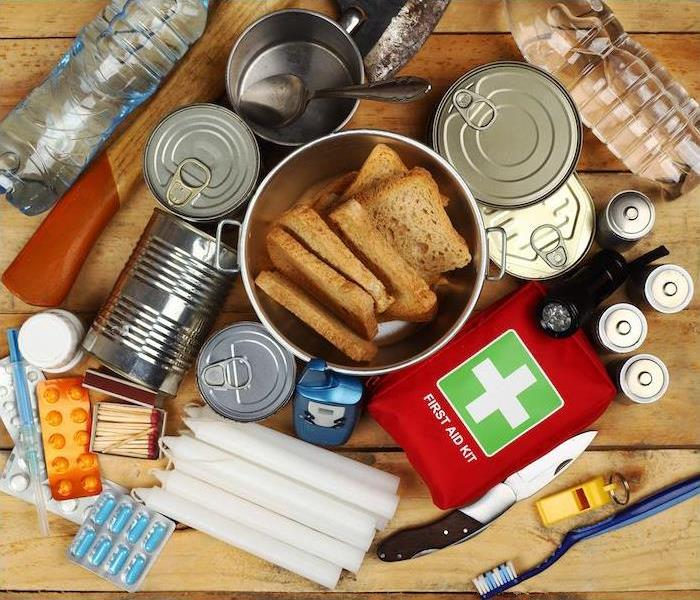 Prepare for fall weather risks with SERVPRO®. Stay safe by creating an emergency plan and staying informed—reach out to us for expert support!
Prepare for fall weather risks with SERVPRO®. Stay safe by creating an emergency plan and staying informed—reach out to us for expert support!
Fall storms in Colorado can be both sudden and severe, bringing everything from intense winds and heavy rain to flooding and falling trees. The aftermath of such storms can leave your home in a state of disarray, making recovery seem overwhelming.
At SERVPRO of Pueblo, we understand the unique challenges posed by Colorado’s fall weather and are here to guide you through the essential steps to take if your home has been damaged. Here’s how to effectively manage the situation and begin the recovery process.
Assess the Damage SafelyThe first crucial step after a fall storm is to safely assess the damage to your property. Start by inspecting the exterior of your home from a safe distance, looking out for hazards such as downed power lines or unstable structures.
Once you’ve ensured it’s safe to enter, use a flashlight rather than candles to avoid any potential fire risks from gas leaks. Document all visible damage with clear photos or videos, including damage to the roof, broken windows, and any signs of water infiltration. If the damage appears extensive or you’re unsure about the safety of your home, it’s wise to consult with a professional for a comprehensive inspection.
Secure and Mitigate Further DamageAfter assessing the damage, the next important step is to prevent additional issues. If you identify leaks or water damage, take immediate action to minimize further harm. Use tarps to cover broken windows and secure any areas where water might enter.
If standing water is present, be cautious of electrical hazards and avoid using any electrical outlets or appliances until a professional confirms that it’s safe. SERVPRO of Pueblo offers specialized services for water extraction and drying, which are crucial for mitigating further damage and preventing mold growth.
Contact Insurance and Restoration ProfessionalsOnce you’ve secured your home and taken steps to prevent additional damage, it’s time to get in touch with your insurance provider. Report the damage, provide them with all necessary documentation, and follow their guidelines for filing a claim. Concurrently, reach out to restoration professionals like SERVPRO of Pueblo.
Our team is equipped to handle comprehensive damage restoration, including water removal, structural drying, and repairs. By coordinating with both your insurance company and our restoration experts, you can streamline the recovery process and ensure that your home is restored to its pre-storm condition. Navigating the aftermath of a fall storm in Colorado can be challenging, but taking these steps will help you manage the recovery process effectively. SERVPRO of Pueblo is dedicated to assisting you every step of the way, from initial damage assessment to final repairs.
If your home has been affected by a fall storm, contact us today for expert help and support. We’re here to restore your home and bring peace of mind back to you. Call us now to start your recovery journey.
Protecting Your Pipes in Pueblo, Colorado
12/27/2023 (Permalink)
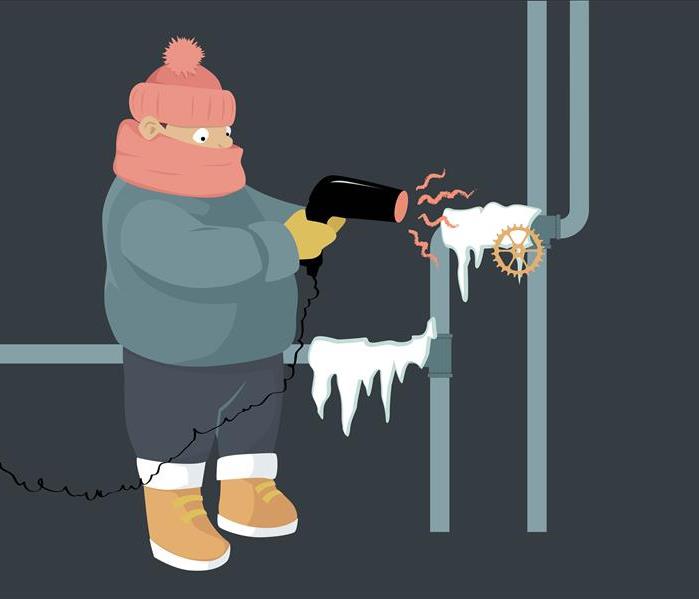 Frozen pipes can cause severe damage to your Pueblo, CO home.
Frozen pipes can cause severe damage to your Pueblo, CO home.
As winter descends upon the charming city of Pueblo, Colorado, residents must prepare for the challenges that come with freezing temperatures. One of the most common and potentially damaging issues during winter is frozen pipes. To help you safeguard your home and avoid the inconvenience of burst pipes, we've put together a comprehensive guide with tailored tips for the unique climate of Pueblo, Colorado.
Understanding the Risk:
Pueblo experiences a semi-arid climate with cold winters, making it susceptible to freezing temperatures that can pose a threat to unprotected pipes. When water freezes, it expands, creating pressure within the pipes and increasing the risk of cracks and leaks. To prevent potential damage and costly repairs, it's crucial to take proactive measures to protect your plumbing system.
7 Steps To Avoid Frozen Pipes
- Insulate Exposed Pipes:
Identify areas where pipes are exposed to the cold and insulate them properly. Focus on pipes in attics, crawl spaces, and exterior walls. Use foam pipe insulation or heating tape to create a barrier against the freezing temperatures, ensuring your pipes remain warm and intact.
- Seal Leaks and Gaps:
Inspect your home for any gaps or cracks that may allow cold air to seep in and affect your pipes. Seal these openings using caulk or weatherstripping. Not only does this contribute to insulation, but it also enhances overall energy efficiency in your home.
- Maintain a Consistent Indoor Temperature:
Keep your home comfortably warm, even when you're away. Setting your thermostat to a consistent temperature helps prevent freezing by ensuring that your indoor spaces remain adequately heated.
- Allow Faucets to Drip:
On extremely cold nights, allow faucets to drip slightly. This continuous flow of water, even at a minimal rate, reduces the risk of pipes freezing by keeping the water in motion.
- Open Cabinet Doors:
In areas of your home with exposed pipes, such as under sinks or in cabinets, open the doors to allow warm air to circulate. This simple step helps maintain higher temperatures around vulnerable pipes.
- Disconnect and Drain Outdoor Hoses:
Before the winter chill sets in, disconnect and drain outdoor hoses. Shut off the water supply to outdoor faucets and store hoses in a sheltered location. This prevents water from freezing in the hoses and prolongs the life of your outdoor plumbing fixtures.
- Schedule Professional Inspections:
Consider hiring a professional plumber to inspect your plumbing system before winter arrives. An expert can identify potential issues, insulate vulnerable areas, and provide valuable advice on protecting your pipes during the coldest months.
Taking these proactive measures will significantly reduce the risk of frozen pipes in your Pueblo, Colorado home, allowing you to enjoy the winter season without the worry of potential plumbing damage. Winter-proofing your plumbing system is an investment in the longevity of your home, ensuring a cozy and stress-free winter for you and your family. Stay warm, stay prepared, and welcome winter with confidence in your well-protected home.
Winter-Proofing Your Home in Pueblo, CO: A Comprehensive Guide to Seasonal Preparedness
11/9/2023 (Permalink)
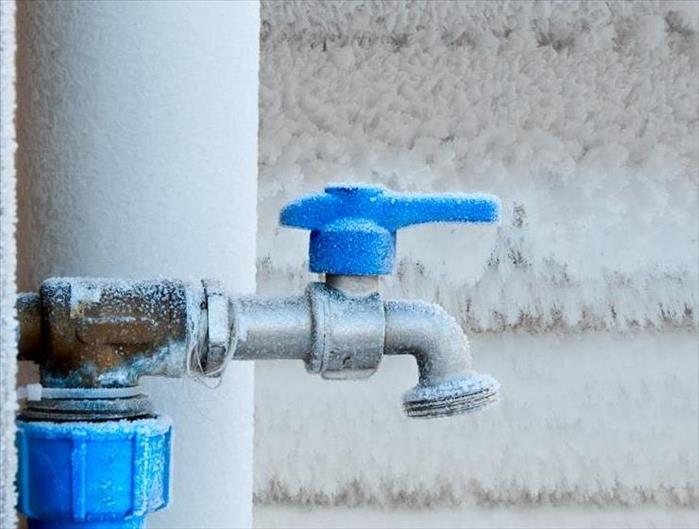 Frozen pipes are a common winter woe in Pueblo, CO.
Frozen pipes are a common winter woe in Pueblo, CO.
As the seasons change, Pueblo, CO, transforms into a winter wonderland, painting picturesque scenes of snow-covered landscapes. However, with the beauty of winter comes the responsibility of preparing your home to withstand the challenges that colder temperatures can bring. In this comprehensive guide, we'll delve into the nitty-gritty details of winter-proofing your home in Pueblo, offering valuable insights and actionable tips to ensure your property remains safe, warm, and damage-free throughout the winter season.
7 Tips To Ensure Your Property is Winter-Proofed
Roof and Gutters: Shielding Your Home from Above
The first line of defense against winter's onslaught is your roof. Inspect it for damaged or missing shingles, as they can lead to leaks and water damage when snow and ice accumulate. Clean out gutters and downspouts to prevent ice dams, a common issue in colder climates. Ice dams can cause water to seep into your home, leading to structural damage and potential mold issues. Ensure that your attic is adequately insulated to prevent heat from escaping and contributing to ice dam formation.
Windows and Doors: Battling the Winter Draft
Drafty windows and doors not only make your home chilly but can also spike your heating bills. Conduct a thorough check for gaps and cracks around windows and doors, and seal them with weather stripping or caulk. Consider upgrading to energy-efficient windows, which can provide better insulation and save you money in the long run. If you have storm windows, make sure they are properly installed to provide an extra layer of protection against the cold.
Pipes: Guarding Against Freezing and Bursting
Frozen pipes are a common winter woe that can lead to costly repairs and water damage. Insulate pipes in unheated areas, such as the attic, basement, or crawl spaces, using pipe insulation. Disconnect and store garden hoses, and shut off outdoor water valves. During extremely cold nights, let faucets drip to prevent freezing. Familiarize yourself with the location of your water shut-off valve in case of emergencies, and consider insulating the valve to prevent it from freezing.
Heating System: Ensuring Warmth and Efficiency
Your heating system is the lifeline of your home during winter, so it's essential to ensure it's in top-notch condition. Schedule a professional inspection to identify and address any potential issues. Change air filters regularly to maintain efficiency and improve indoor air quality. Consider investing in a programmable thermostat to regulate temperatures and reduce energy consumption. If you have a fireplace, have the chimney cleaned and inspected to prevent chimney fires, and use seasoned wood to minimize creosote buildup.
Landscape: Taming the Winter Wilderness
While winter may slow down the growth of your garden, it's essential to prepare your landscape for the colder months. Trim overhanging tree branches that could pose a threat during heavy snowfall, preventing potential damage to your home. Clear dead leaves and debris from your yard to avoid issues when the snow melts. Consider hiring a professional to winterize your irrigation system, protecting it from freezing temperatures.
Emergency Preparedness: Ready for Anything
Winter storms can bring unexpected challenges, from power outages to impassable roads. Equip your home with emergency supplies, including flashlights, batteries, blankets, and a well-stocked first aid kit. Familiarize yourself with local emergency services and have a plan in place for evacuation or sheltering in case of severe weather. Keep a supply of non-perishable food and water on hand, and make sure your family knows what to do in case of an emergency.
Supplies: Stocking Up for Winter Woes
Prepare for winter storms by stocking up on essential supplies. Keep salt or ice melt on hand to de-ice driveways and walkways, preventing slips and falls. Have sand available for added traction. Ensure your snow removal equipment, such as shovels and snow blowers, is in good working order. Consider investing in a generator to keep essential appliances running during power outages.
Winter in Pueblo, CO, is a magical time, but it requires careful planning and preparation to ensure your home remains a haven of warmth and safety. By following these comprehensive tips, you can winter-proof your home and enjoy the beauty of the season without the worry of potential storm damage. From the roof to the foundation, every aspect of your home plays a role in its ability to withstand the winter elements. Take the time to assess and address these key areas, and you'll be well on your way to a cozy and stress-free winter in Pueblo. Embrace the season, and let your home be your sanctuary in the midst of the winter chill.
Dealing With Roof Damage After a Storm
8/18/2023 (Permalink)
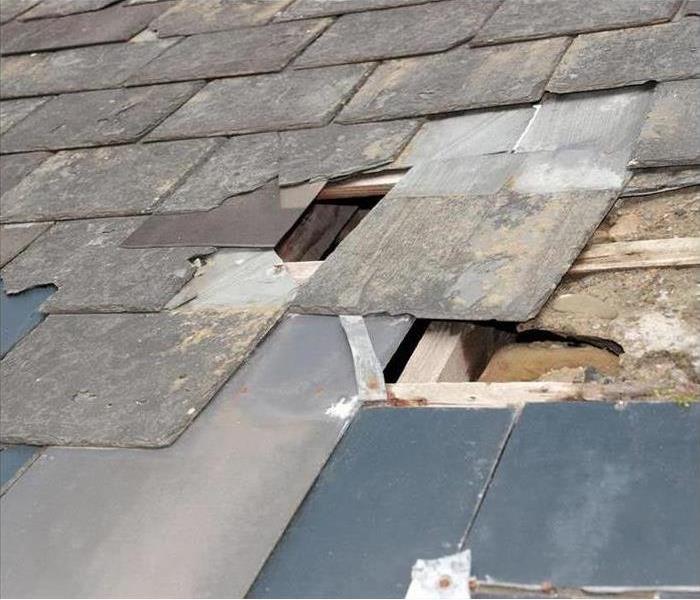 Roof damage after a storm in Pueblo, CO.
Roof damage after a storm in Pueblo, CO.
Severe weather can cause extensive damage to a house, which is why storm preparations are strongly urged by storm remediation experts in Pueblo, CO. One of the most likely damages is roof damage. Roofs are often affected by wind, rain, and flying debris, which is why experts suggest performing inspections after any severe storm.
The Necessity of Remediation After Roof Damage
Whether the cause of damage to a roof was rain, debris, or wind damage, it is necessary to call on a professional service to make any necessary repairs. Leaving your roof in disrepair can lead to more significant damage. Many roofing experts warn of four issues that can stem from a damaged roof.
- Water Damage
When a roof is damaged, the underlayment is exposed. The foundational layer of the roof is not as protective against moisture as the external layers. Therefore, when shingles and moisture barriers are damaged, it is not long before you start seeing water inside your home.
The leaks often start as drips, but those drips will turn into full-blown leaks if you leave a roof unrepaired. Soon enough, you will have numerous pots and pans collecting water during storms.
- Mold
Mold is typically a natural side effect of moisture. No matter how clean your home is, mold spores are everywhere. If these spores locate a sustainable water source, they land and multiply. Within two days, you can have a colony requiring expert removal.
The problem with a damaged roof is you do not always notice an issue until it is too late. Not all leaks are noticeable, mainly if they occur in an attic space and are minor. Because mold can grow so fast and not all leaks are noticed, inspecting your home after every rainstorm is crucial especially severe ones.
- Structural Damage
Remediation is crucial when a roof is damaged because the damage can result in structural issues. When problems get ignored, a minor roof repair can lead to ample moisture and rot problems later. Water is no friend of wood, which is why so much effort is put into waterproofing your home.
The sheathing and beams that make up your roof and connect your walls are vulnerable to moisture. Too much exposure can lead to rot, mold, and decay. Eventually, with unmitigated exposure, holes will emerge in the structure, and beams will fail.
- Safety
The primary reason for remediation after storm damage is safety. When the structure of a home is called into question, the only appropriate response is to repair it. A damaged roof can evolve from water damage to mold damage and worse. Keeping your family safe means taking the right actions in a timely manner.
Roof damage is a significant possibility of severe weather. The damage can range from minor to severe, but regardless of the degree of the initial damage, quick response to repairs is necessary to maintain the security and safety of your home. Remediation experts are your best resource for such maintenance, especially if there is any level of expectation of danger or uncertainty.
The Importance of Timely Flood Damage Mitigation
7/20/2022 (Permalink)
 Roof damage due to a storm can cause flooding and damage to your home.
Roof damage due to a storm can cause flooding and damage to your home.
Having the security of flood insurance after a major storm hits Pueblo, CO, is a relief. If the damage it causes is widespread throughout your area, though, it may be a while before your adjuster arrives to assess your home. There are many reasons not to wait on your provider's representative before starting mitigation.
Reasons Not To Wait for the Flood Insurance Adjuster To Arrive
Under normal circumstances, insurance adjusters are tasked with making sure the information provided by clients on claims is accurate. If your home has extensive damage, though, it may only get worse if you wait to start the remediation until after the adjuster visits. Quick action is necessary for several reasons.
Before any work can be done, you must know the full extent of the problem. The flood damage mitigation experts you hire to fix what's wrong with your home are trained to provide an accurate assessment of the issue. They go beyond the surface for a thorough investigation of potential issues:
- Contamination level
- Air quality
- Structural integrity
- Saturation extent
- Secondary damage
Adjusters list all the problems they see but certified mitigation experts understand what the actual cleanup process entails. Thus, they know the specific problems to look for and are likely to catch something that the adjuster might miss. They can also take pictures and provide an itemized list of work that needs to be done to aid the adjuster in getting an accurate picture of the original state of your home after the flood.
Just like any other liquid, water continues to cause problems as long as it's someplace it's not supposed to be, and if you neglect to act in a timely manner, your flood insurance policy may not cover extended damage. Even if you are able to pump the majority of the standing water out of your home, the excess moisture that inevitably stays behind is still seeping into your flooring and your baseboards. The water that is already in your drywall will continue to expand until it's completely cut out. The faster your response, the more likely it is that some materials can be salvaged.
Another common issue that arises with unmitigated water damage is mold growth. You may think that you have plenty of time to start cleanup, but the truth is that mold damage can occur within as few as 24 hours after the initial flood happens. This is especially true of the spaces in your home that may already be prone to fungus growth, such as the bathroom and laundry room. Waiting for an adjuster to survey your house only paves the way for mold to exacerbate the issue.
Your flood insurance provider is certainly one of the first calls you should make when your home is flooded. If the damage occurs as a result of a storm, though, adjusters in your area may be very busy and thus delayed. Don't wait to start the cleanup process. Your mitigation team can provide the thorough assessment that your insurance company needs while stopping damage in its tracks.
The Facts About Thunderstorms
7/19/2022 (Permalink)
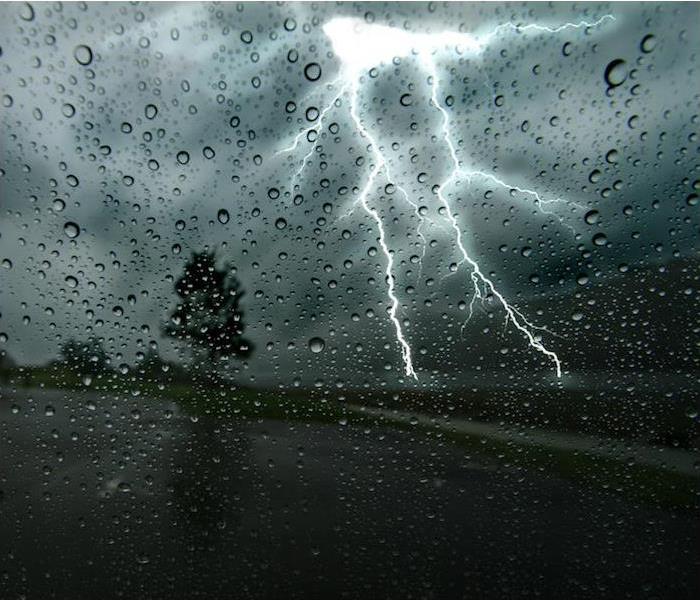 Thunderstorms can pop up at any moment.
Thunderstorms can pop up at any moment.
When you think about severe weather, hurricanes and tornadoes may come to mind. If you’re thinking globally, things like cyclones and monsoons may also be thought of.
But you may forget all about thunderstorms.
Thunderstorms occur so frequently that we often fail to think of them as dangerous, which can be a problem in and of itself. While many thunderstorms pass without incident, there are those that do not—and between high winds, lightning, hail, flooding and other issues that thunderstorms can cause, there are many ways that the weather can turn dangerous quickly.
By definition, thunderstorms are any storm that involves thunder. By extension, that also means they include lightning, since the two always go hand-in-hand, even if you don’t see the lightning.
Most of these storms are inconsequential, but they can quickly turn severe in the right conditions. Severe thunderstorms are defined as storms that contain hail that is one inch or larger and straight-line winds of 58 miles per hour or more.
Why Thunderstorms Are Dangerous
- Damage and injury from lightning strikes.
We mentioned above that lightning always accompanies thunder. It’s also incredibly dangerous, and it is reported that lightning strikes cause around 300 injuries every year. Bodily harm is one key danger, but lightning strikes can also damage property, both directly and indirectly through things like trees falling on homes after a strike.
- Property damage due to hail.
You probably know what hail is, and you may consider it a danger to your car. But it’s also a danger in other ways. These ice pellets vary in size from tiny to very large. Their size, as well as how quickly they fall, contribute to how dangerous they are. Large hail, propelling quickly, can damage your roof and siding, which may lead to a leak and resulting water damage.
- Harm from flash flooding.
Flash floods can occur any time there is heavy rain for a plethora of reasons—even if storm drains back up or small ditches become filled with water, heavy rain can quickly turn these things into a life-threatening flooding scenario. This type of flood earned its name; they literally occur in a flash, endangering people around the area. If flash flood conditions are present, stay off the road.
Thunderstorms are dangerous and can cause significant damage to homes or commercial spaces in Pueblo, CO. If you have damage due to a thunderstorm, you can count on us to help. C
4 Critical Steps for Roof Damage and Water Damage Mitigation
5/26/2022 (Permalink)
 Follow these Steps and avoid Water Damage in your Property.
Follow these Steps and avoid Water Damage in your Property.
The roof over your home is in a precarious location. It often takes the brunt of everything from high winds to heavy rains to hail and snow. It is not surprising that roof damage is common after a powerful storm. When this happens, your home in Pueblo, CO, is even more exposed to the elements and quick action needs to be taken. Failure to act could result in another storm sweeping in and pouring water onto the interior of your residence.
To secure your home after an extreme weather event, it is important to get professional help. Working with a storm damage restoration company in your area is a smart choice, particularly if you have gaps in the roof or extensive damage to shingles. A local franchise can arrive quickly and begin to secure your exposed home with appropriate actions.
Important steps to avoid Water and Roof Damage.
1. Roof Tarping Services
The first step could be putting a waterproof barrier in the form of a tarp over your house. This will prevent additional wind damage and keep moisture from ruining carpeting, furniture, personal belongings and insulation. It will place a barrier over your home until more permanent repairs can be made. Erecting a tarp over a home is an inherently risky job so it is best left to professionals who will follow critical safety protocols and use suitable equipment.
2. Roof Damage Inspection
When looking at the roof after storm damage, trained workers will make sure everyone in the home is safe. This could include asking your family to vacate the premises for a time. Other steps could include making sure electrical hazards are addressed and contacting the power company to repair downed power lines. The initial roof inspection will be done from the ground for safety purposes. Only when the roof is deemed safe, will the inspection proceed to go up on the roof.
3. Restoration and Rebuild
Wind damage to shingles and the tearing off of roof boards will require construction services. The goal is to restore the roof to its original condition so it can once again protect your home during extreme weather. A successful job includes completing the roof mitigation on time and within budget. It allows your family to move back into the home and feel secure. A quality construction contractor will coordinate with your insurance company to expedite the claims process.
4. Water Damage Assessment
As roof repairs proceed, workers will also need to inspect the home for signs of water damage. Any standing water will need to be removed from the home and drying equipment will be necessary to remove excess moisture. The severity of the damage determines the most appropriate steps to take. If structural damage has occurred, a remediation and construction plan will be communicated to the homeowner. You should be informed of all steps along the way, and you will not need to be in the home at all times while repairs are being made.
It is an unfortunate event when roof damage exposes your home to the elements. With the proper steps, though, your home can be restored to its original condition.
How To Get Ready for Storm Season
2/23/2022 (Permalink)
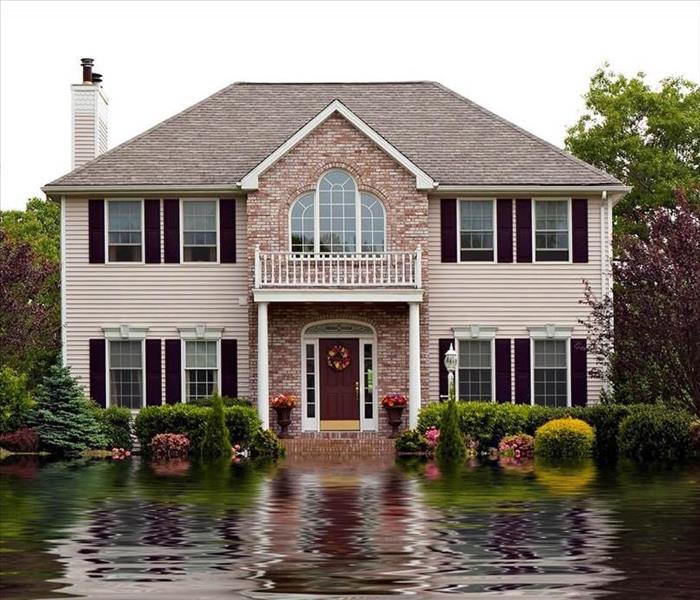 Get Ready for Storm Seasons by following These Tips. If you have more questions, just contact us.
Get Ready for Storm Seasons by following These Tips. If you have more questions, just contact us.
Every area has its own storm season. Some people experience heavy snow and ice while others have to watch out for damaging winds and hail. Flooding is often a factor during a storm no matter where you live, though. When storm season approaches in Pueblo, CO, there are a few things you can do to get ready.
Prepare Your Home
Your main goal in getting your home ready is to secure it so that you prevent as much flood damage as possible. A solid flood maintenance checklist will include inspection and repair of several areas of your property:
- Trim trees and shrubs to get rid of branches that can easily break off
- Install storm windows or shutters
- Seal all openings around doors and windows
- Check the roof for damage or weak spots
- Clean gutters and downspouts
- Inspect the foundation for fissures
- Insulate pipes
It is likely that many of these things are already on your regular maintenance to-do list, but they are especially important when you're expecting a flood. The stronger defense your home has against leaks, the lower the chance that you will have to have major repairs after the first major storm passes.
Stockpile Necessities
Whenever there is a strong weather event, services that typically function smoothly can be disrupted. Ice or heavy winds can break power lines, causing your home to lose electricity. Additionally, pipes may freeze if temperatures stay too low for too long. In addition to flooding concerns, you may also have to find alternative ways to keep your family warm and fed.
Start with water and food. You should have a three-day supply of drinking water for every family member as well as shelf-stable food that you can prepare without the use of your appliances. Keep your flashlights with extra batteries and a tool kit handy. If any family member needs regular prescriptions, make sure you keep them in a safe, dry place that you can access easily. Finally, make sure that your first aid kit is up to date and fully stocked.
Compile a List of Emergency Numbers and Inventory
It's always a good idea to have emergency numbers listed in a prominent location in your home, but it's vital during a storm. It's not hard to remember 911, but other people you may need to contact include storm damage mitigation experts, your family doctor or pediatrician and your insurance provider. That way, if there is damage or you need medical advice, you can reach them via landline if your cell phone dies.
You should always keep a running inventory of the items in your home and the cost it would take to replace them. It's smart to store an electronic copy in a secure location online so that even if the original list is destroyed in a storm, you still have access to it. This information is crucial for filing an insurance claim if covered items are damaged.
You can't control the weather, but you can do everything in your power to prepare for it. By checking things off your pre-season maintenance list, you may be able to save your home from the effects of major flooding.
Protecting Your Home Against Flood Damage
2/16/2022 (Permalink)
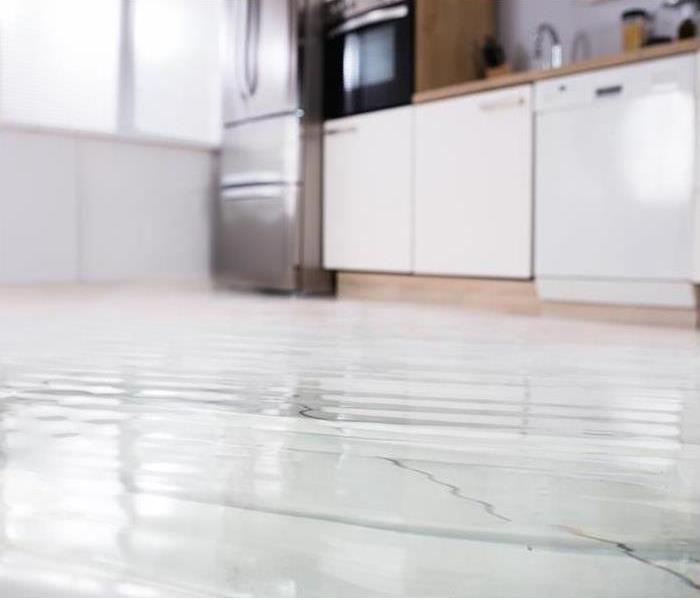 Floods can lead to severe damage in your Pueblo, CO home. Call us to avoid future risks.
Floods can lead to severe damage in your Pueblo, CO home. Call us to avoid future risks.
Worrying about flooding in your Pueblo, CO home may seem counterintuitive if you are not in an area prone to flooding, but with natural disasters involving flooding around 90% of the time, it would be unwise for homeowners to not prepare their homes in case of a flood.
Ways Homeowners Can Protect Against Flood Damage
While there is no way to practice prevention for floods, there are steps homeowners can take to limit the damage a flood may cause:
Know your risk. Use the FEMA Flood Map Tool or call the local branch of your emergency management office to better understand your risk and the precautions to take.
Discuss emergency procedures. Keep the entire family aware of the emergency and evacuation plan for the house. Teach every adult how to turn off the electricity main and make sure emergency supplies are easily accessible.
Elevate valuables. Important documents pertaining to the household, such as insurance papers, should be kept in a place that would be easily accessible and protected should you need to file a claim following the flood.
Prepare appliances. In the case of a shallow flood, appliances such as washers and dryers can be elevated on bricks or stands to protect the internal workings from water damage.
Turn off electricity. Even if you feel it’s unlikely that the waters would reach electrical appliances or outlets, prevent the risk of shock or electrocution by turning off the electricity supply to rooms that are at risk.
Raise hazardous materials. By elevating things such as oil, paint and cleaning supplies, you can prevent dangerous substances from spilling into the floodwater.
Anchor propane and fuel tanks. A tipped propane or fuel tank can pollute floodwaters or pose an explosion risk. Fuel tanks should be securely anchored.
Disasters such as floods are devastating, but a bit of pre-planning can go a long way in protecting your valuables and keeping your family safe.
If you’ve experienced water damage due to a flood or other causes, SERVPRO® of Pueblo is here to help. Our technicians are fully trained in water remediation, and our 24⁄7 Emergency Line means we’ll be there for you when you call.
How To Prevent Mold Damage After a Flood
1/20/2022 (Permalink)
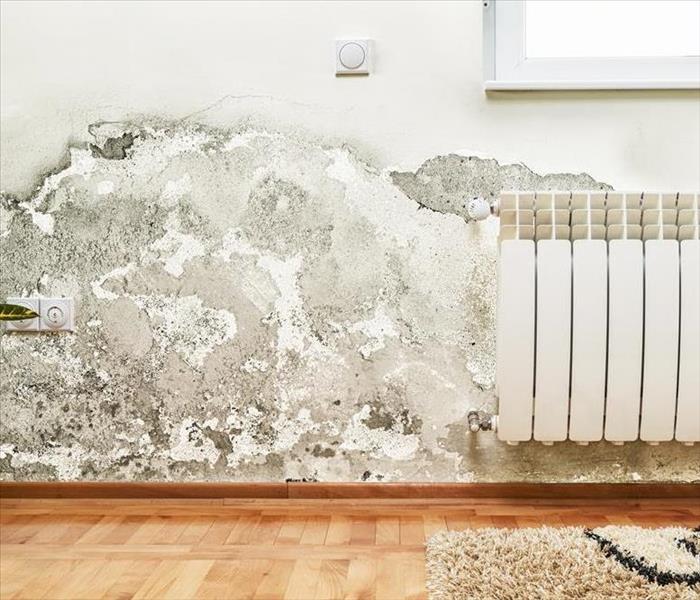 Prevent mold growth in your Pueblo, CO home by following these tips.
Prevent mold growth in your Pueblo, CO home by following these tips.
Flooding from a storm in Pueblo, CO, can cause a lot of water damage to your home. If you don't address the problem quickly, however, that may become only part of your concern. Mold growth is a common side effect in damp spaces, and once it starts to thrive, it can be difficult to get rid of. There are several things you must do to protect your home against a significant mold problem after a storm.
Important tips to prevent Mold Damage after a Flood
Quick Mitigation
The best thing you can do to prevent mold is to deprive it of the elements it needs to propagate. Mold can start to grow within as few as 24 hours after a flooding event because your home has become a fertile breeding ground for spores. They feed on not only the excess moisture itself but the bacteria in the floodwater.
A quick mitigation process is the key to stopping fungus from spreading. As soon as certified remediation experts arrive at your home, they begin the cleanup process:
- Assess the water and mold damage
- Remove excess water
- Tear out ruined materials
- Disinfect remaining structure
- Dry affected area
- Rebuild the affected area in your home
The sooner this takes place, the earlier you can get rid of any existing mold issues. You may even be able to prevent mold patches from starting to form at all!
Fast Repairs
Another piece of the prevention puzzle is getting to the root of the problem. Floodwaters that cause mold growth enter your home through points of egress. Start at the bottom of your home and work your way up. Look for cracks in the walls that indicate weak spots or a shift in the foundation and call professionals for repair. Seal the space around doors and windows so that rain can't get inside. If there are holes in your roof, have them patched quickly to prevent damage to the attic and upper levels of your home. Eliminate the sources of the moisture problem, and you can circumvent mold issues as well.
Humidity Control
Standing water doesn't just affect the surfaces it touches. After a flood, the air itself takes on extra moisture. High humidity levels can dampen surfaces and encourage mold spores to settle and multiply. There are a couple of things you can do to keep this from happening, though. Before mold has a chance to settle, increase the airflow in your home as you are getting rid of the excess water. This helps dry both the surfaces and the air. You can further reduce humidity by running a dehumidifier in the space.
Ongoing Inspections
After the mitigation team has completed the restoration of your home, watch for signs of recurring issues. A musty odor is an indication that you need to look for mold patches or call for an inspection. If mitigation is done properly, the mold is unlikely to return, but inspecting your home for new leaks or other problems helps you stay on top of it.
Mold growth is not a pleasant problem to deal with, but it can be eradicated from your home. Taking swift action and putting prevention measures into practice help keep the problem at bay.
What to Know About Summer Storms | SERVPRO® of Pueblo
8/17/2021 (Permalink)
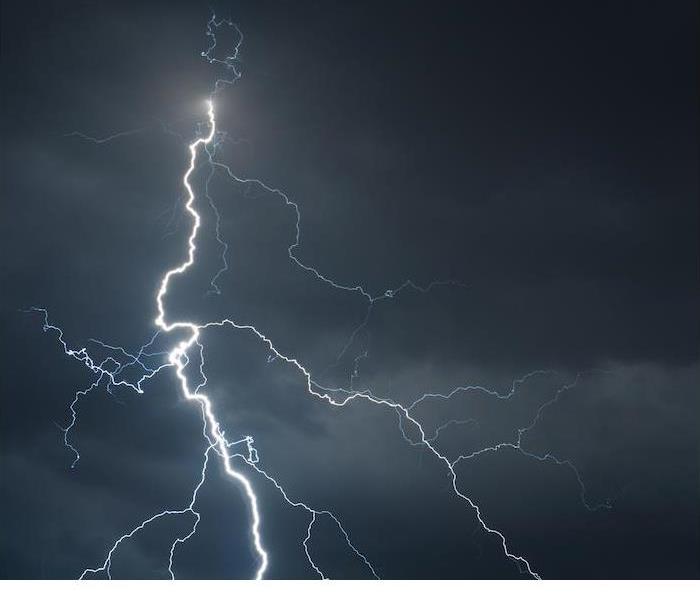 If storms cause damage to your home or business, SERVPRO of Pueblo is on the line, ready to make things right.
If storms cause damage to your home or business, SERVPRO of Pueblo is on the line, ready to make things right.
Sweet summertime always reminds us of family events, mostly outdoors!
It may also seem that summer can bring more thunderstorms than any other time of the year, and it’s totally true. In most parts of the country, there are atmospheric conditions that create moisture and warm air, which helps create thunderstorms.
Here in Pueblo, from mid-July to mid-August, the rain chances double.
Alert and Aware
While thunderstorms are quite common for almost every place, they should never be taken lightly. Make sure you’re always aware and prepared by getting storm alerts or making other arrangements for outdoor activities.
In case you lose power, it might be smart to purchase an NOAA Weather radio so that you can receive weather alerts.
Flooding is rarely predictable and always possible.
You should make preparations to stay off the roads. “Turn around don’t drown” is a common saying because water along the roads can easily sweep your car off the road.
Dozens of people die every year because of storm-related accidents. Never ignore a simple thunderstorm, because it can easily become dangerous without much warning.
Playing It Safe
If lighting presents itself, stay indoors. It’s not safe to go back outside until you haven’t heard thunder in at least a half hour.
During these stormy events, stay away from windows and avoid bathing or showering.
Here in Pueblo, we get a lot of flash flood warnings or watches, so it’s smart to keep an emergency kit prepared and ensure that you know the evacuation route for your area.
If flooding occurs, make sure to stay off the roads, by vehicle or foot. Flood waters can present many dangers, either sweeping your car away or causing electrical issues.
There are any number of dangers that can come into play in a thunderstorm, and it’s always best to be cautious and put things on hold until storms safely pass. If storms cause damage to your home or business, SERVPRO is on the line, ready to make things right again.
The Impact of Severe Weather | SERVPRO® of Pueblo
7/8/2021 (Permalink)
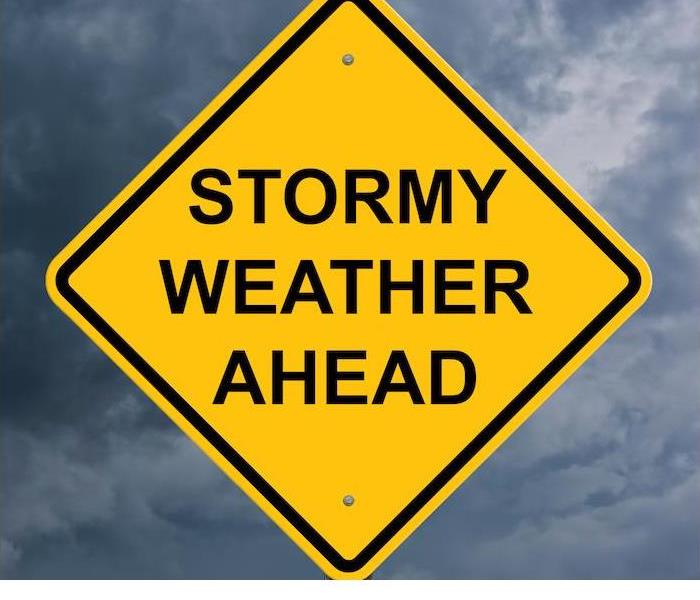 When storms do damage, we go to work to make things right. Contact SERVPRO of Pueblo to start the restoration process.
When storms do damage, we go to work to make things right. Contact SERVPRO of Pueblo to start the restoration process.
The year 2020 will be one for the books to say the least. In addition to the drama that ensued, it was also a record-setting year for weather and climate disasters. Of all the years in history for which we have data, 2020 was the most financially destructive.
During 2020, there were 22 official weather disasters, which are defined as events that cause at least a billion dollars in damages.
There were also many other damaging storms that weren’t accounted for in that statistic. In fact, there were so many named hurricanes and tropical storms that for only the second time in history, the NWS had to dip into the Greek alphabet just to be able to name them all.
Just How Severe Are We Talking?
Hurricanes can do some mass destruction and in turn cost large monetary amounts in damages, but crazily enough, it’s not only the hurricanes that are doing this.
In fact, the most expensive disasters of 2020 in the contiguous United States were thunderstorms and tornadoes.
In 2020, it was reported that 14 of the official weather disasters were severe thunderstorms, and some of which unleased ravaging tornadoes as well. Thunderstorms don’t discriminate, they happen anywhere and during all seasons of the year.
In Nebraska in August 2020, a single storm system became extremely damaging. A seemingly typical line of thunderstorms exploded into a derecho (something like a tornado but with straight-line winds instead of swirling ones) and impacted more than 10 million acres of corn fields, that’s over 11% of the entire country’s corn fields.
In Pueblo, hail and flooding are no strangers to the area. People often talk about the storm that “reshaped Pueblo.” In early June 1921, torrential rains swelled the Arkansas River to a mile wide and 15 feet deep in some places. There was talk that the death toll took many lives, including telephone operators who stayed at work to send out warnings.
Is This the New Normal?
When it comes to weather nowadays, it seems that 2020 hasn’t really been an outlier, but in fact it’s becoming the new normal.
2020 was the 10th consecutive year with at least eight billion-dollar disasters. For 2018 and 2019, we saw a combined total of $136 billion in damages, and in 2017, the damage total was over $300 billion.
Storms are normal—what’s changed is that their frequency and intensity are showing no signs of diminishing. That’s why as a home or business owner it’s important to take whatever precautions are possible.
No matter the precautions you take, it’s important to know that things are beyond your control at times. So remember you’ve got a friend in the restoration industry whose goal is to recover your valued items and restore your property "Like it never even happened."
When storms do damage, we go to work to make things right. Contact SERVPRO today to see how we can help.
Is Your Home Ready for Spring Thunderstorms? l SERVPRO® of Pueblo
3/3/2021 (Permalink)
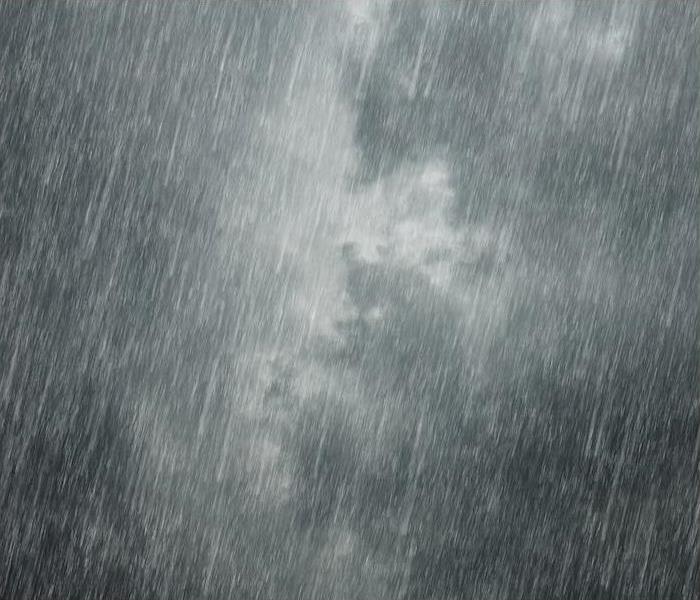 Is Your Home Ready for Spring Thunderstorms? l SERVPRO® of Pueblo
Is Your Home Ready for Spring Thunderstorms? l SERVPRO® of Pueblo
Are you ready for a new season? Most of us are!
As February turns to March, spring is definitely in the air. And many of us are starting to plan new projects and find different ways to brighten up a new season.
Maybe you’re an avid gardener planning your next landscaping project. Or maybe you’re looking for new ways to prepare old favorites on the grill.
Regardless of how you’re planning to spend spring, it’s a good idea to make time for home maintenance now, so you’re protected for one of spring’s weather threats—strong thunderstorms.
We can’t stop storms from hitting our homes and communities. But we can make sure our homes are as safe as possible when it happens.
Projects to Help You Keep Your Home Safe From Storms
It’s worth the effort to add these items to your seasonal to-do list:
Inspect your roof for issues. You want to be sure your roof is in good shape if a storm starts hitting. Check for things like missing shingles and signs of leaks. Repair them to keep your home safer.
Don’t leave items around your home unsecured, either. Don’t let unsecured furniture or other similar items become tools for wind damage. Trim back trees that need it and secure everything you can.
Don’t let tree limbs cause a problem. Tree limbs overhanging your home can fall during heavy winds. You can fix this issue, though. Cut down limbs or branches hanging over your garage and roof.
Ensure your sump pump is working (if you have one). Every homeowner doesn’t need one of these. But if you do need one to regulate water levels in your basement, it’s vital to keep it working. Be sure yours is in good shape before it starts raining.
Keep your gutters clean. This step is vital every season. Clean, clear channels are vital to keeping water around your home flowing the right way, instead of causing water damage.
If a fire, flood or any other cause damage to your home, you can always count on us for restoration assistance. We are available 24⁄7 in the event of an emergency. Contact us at any time to learn more about our restoration services and how we can help you.
 Prepare for fall weather risks with SERVPRO®. Stay safe by creating an emergency plan and staying informed—reach out to us for expert support!
Prepare for fall weather risks with SERVPRO®. Stay safe by creating an emergency plan and staying informed—reach out to us for expert support!





 24/7 Emergency Service
24/7 Emergency Service











